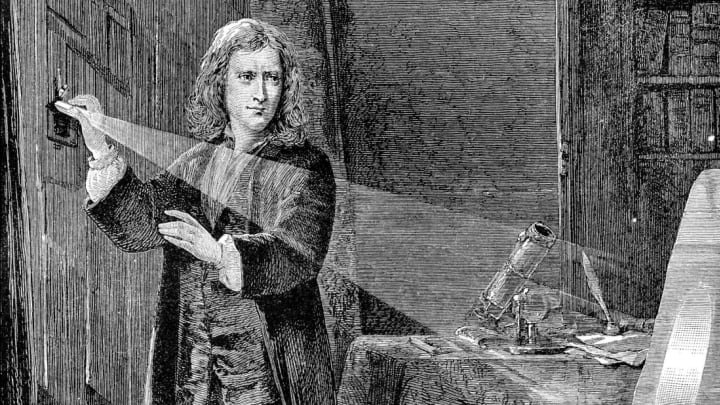7 Great Scientists Who Were Born on Christmas Day
By Mark Mancini

From the man who discovered titanium to a prehistoric plant expert, these Christmas-born scientists helped us better understand the natural world and our place within it.
1. John Phillips (1800-1874)
John Phillips was born on December 25, 1800. In 1808, when he was just 7, he lost both of his parents and was taken in by his uncle William Smith, a surveyor and fossil hunter known as the “father of English geology.” Phillips also became a great geologist, and in the 1840s, he drew upon his uncle’s work to identify and name three significant eras in Earth’s history: the Paleozoic, Mesozoic, and Cenozoic. He also authored several papers on astronomy.
2. William Gregor (1761-1817)
A British chemist, mineralogist, painter, clergyman, and Christmas kid, William Gregor is most remembered as the man who discovered titanium. He first came across a sample of this element on the sandy banks of a stream that ran near the Cornish village of Manaccan in 1790. In a paper describing the metal, Gregor proposed calling it menacanite or menachine. Meanwhile, German chemist Martin Klaproth independently discovered titanium in 1796, and this was the name that stuck [PDF].
3. Richard E. Shope (1901-1966)
The 1918 influenza pandemic killed between 20 and 50 million people worldwide; 28 percent of Americans were infected. At the same time, pigs in the Midwest were dying of a similar illness.
Richard E. Shope, a pathologist at the Rockefeller Institute for Medical Research, suspected the two outbreaks were related. In 1928, Shope visited Iowa—where he had been born on Christmas Day in 1901—and began testing infected pigs for a bacterial pathogen, since many scientists thought the flu was caused by a bacterium. His experiments failed to reveal the culprit. He then filtered samples of the pigs’ mucus to remove bacteria and exposed healthy pigs to the samples. Those pigs came down with porcine influenza, demonstrating that the flu was caused not by bacteria, but by a “filter-passing agent”—in this case, a virus.
Further research by other scientists showed that human and pig influenza were closely related. Building off of Shope’s research, a British team isolated the human influenza virus for the first time in 1933. This breakthrough allowed the development of flu vaccines.
4. Gerhard Herzberg (1904-1999)
Spectroscopy is a technique that allows scientists to study the interactions between matter and electromagnetic radiation. Gerhard Herzberg literally wrote the book on it: His three-volume textbook titled Molecular Spectra and Molecular Structure is the gold standard for the field.
Herzberg was born on December 25, 1904 in Hamburg, Germany. As a boy, he could often be found studying chemistry and astronomy. By age 25, Herzberg had earned a doctorate in engineering physics and published 12 scientific papers. Herzberg and his Jewish wife, astrophysicist Luise Oettinger, left Germany when the Nazis came to power and relocated to Canada. In 1952, Herzberg detected hydrogen gas molecules in Uranus and Neptune’s atmospheres and led studies into free radicals (atoms or groups of atoms with an odd number of electrons). Herzberg’s body of work earned him the Nobel Prize for chemistry in 1971.
5. Inna A. Dobruskina (1933-2014)
Paleobotanist Inna Dobruskina was one of the world’s leading authorities on plant life during the Triassic period (between 252 and 201 million years ago). She was born in a communal apartment in Moscow on December 25, 1933, and taught at the Geological Institute of the Soviet Academy of Sciences, where she secretly distributed anti-Communist pamphlets for several years. Her work took her to Triassic deposits in China, France, Austria, South Africa, Russia, and the United States. In 1989, she emigrated to Israel, where she became a faculty member at the Hebrew University of Jerusalem.
On one Sino-Soviet expedition along the Amur River, Dobruskina’s male subordinates dared her to down a shot of undiluted alcohol, thinking that she wouldn’t be able to hold her liquor. Dobruskina drank an entire 250-milliliter glass (about 5.5 shots). The men on the team didn’t challenge her again.
6. Adolf Windaus (1876-1959)
Another Nobel laureate born on Christmas Day, this Berlin native took home the 1928 prize for chemistry. Windaus spent his career studying sterols, a class of organic compounds that includes cholesterol. Windaus’s interest in this topic began shortly after he earned a Ph.D. in chemistry from the University of Freiburg. Sterols were not well understood then, and through his research, Windaus discovered that they were similar to bile acids. He also learned that a fungal sterol called ergosterol can be used to cure rickets and determined the chemical composition of vitamin D.
7. Isaac Newton (1642/43-1726/27)
Isaac Newton—pioneering physicist who made discoveries in motion, gravity, optics, and more—was born on December 25, 1642, according to the old-style Julian calendar. Modern historians cite January 4, 1643, on the Gregorian calendar as his actual birthday.
Roman Catholic countries like France and Spain adopted the Gregorian calendar right after it was established by Pope Gregory XIII in 1582. Great Britain, where Newton was born, didn’t follow suit until 1752. For consistency’s sake, historians have retroactively adjusted all pre-1752 years to conform to the Gregorian calendar—so today’s scholars cite January 4, 1643, as Newton’s birthday and March 31, 1727, as his death day.
A version of this story was published in 2018; it has been updated for 2021.